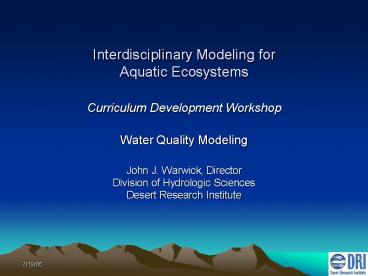Interdisciplinary Modeling for Aquatic Ecosystems - PowerPoint PPT Presentation
1 / 11
Title:
Interdisciplinary Modeling for Aquatic Ecosystems
Description:
Simulate over space and time various important water ... Coffee and Donut Monitoring. Lagrangian Sampling Example. 7/18/05. Surface Water Quality Modeling ... – PowerPoint PPT presentation
Number of Views:26
Avg rating:3.0/5.0
Title: Interdisciplinary Modeling for Aquatic Ecosystems
1
Interdisciplinary Modeling forAquatic Ecosystems
- Curriculum Development Workshop
- Water Quality Modeling
- John J. Warwick, Director
- Division of Hydrologic Sciences
- Desert Research Institute
2
Surface Water Quality Modeling
- What
- Simulate over space and time various important
water quality constituents (e.g., temperature,
dissolved oxygen, nutrients, metals, toxics,
bacteria) - Analytical or numerical solutions
- Deterministic or Stochastic
- Typical spatial scales 10 to 100 km
- Typical temporal scales
- Rivers steady state to years
- Lakes steady state to centuries
- Why
- Understanding
- Prediction/Regulatory (TMDLs)
3
Surface Water Quality Modeling
- How
- First perform flow modeling
- Completely Stirred Tanks Reactor (CSTR) Lakes
- Mass (M), Volume (V), Concentration (C)
- M VC
- Spatially uniform concentration within single
CSTR (impulse load example) - Plug Flow Reactor Streams/Rivers
- No Dispersion (impulse load example)
- With Dispersion (impulse load example)
- Numerical solutions are often for a series of
CSTRs (impulse load example) - Numerical Dispersion
- All solutions are based upon a relatively simple
mass balance approach
4
River Conceptualization
Point Source
Flow
Groundwater, Non Point Source
5
Surface Water Quality Modeling
- Simple Mass Balance
- Mass Flux Rate (MFR) Mass/time
- Change in Mass over time
- Losses, Reaction rate coefficients (K)
- Zero-order
- First-order
6
Surface Water Quality Modeling
- Typical Assumptions, Limitations, and Errors
- Reaction rate coefficients apply globally (i.e.
homogeneous) - Reaction rate coefficients vary with temperature
but are otherwise constant with respect to time - Complex biological systems are simplified greatly
(e.g. abbreviated foodwebs) - Incredible LACK OF DATA
- Coffee and Donut Monitoring
- Lagrangian Sampling Example
7
Surface Water Quality Modeling
- Uncertainties
- Monitoring
- Errors (e.g. sample labeling)
- Overall lack of data
- Uncertainties in data
- Field sampling error
- Laboratory analysis error
- Modeling
- Errors (e.g. decimal point or units)
- Decision Uncertainty
- Model Simplifications
- Steady state
- Homogeneous
- Single variable for multiple species
8
Surface Water Quality Modeling
- Warwicks Modeling Rules
- Carefully review existing data (spatial and
temporal resolutions) - Carefully consider the goals of the modeling
project (what is really needed) - Carefully review existing models and select the
most appropriate for the data and goals - Do NOT assume that the selected model is correct
or that you can correctly run the selected model
(model validation) - Develop an integrated monitoring and modeling
approach including both calibration and
verification - Do NOT underestimate the need for and importance
of technology transfer and public education
9
Surface Water Quality Modeling
- Warwicks Modeling Realities
- Data is VERY limited (get used to it)
- Models will never be perfect (get over it)
- Model documentation is poor (expect it)
- Thoughtfully constructed and applied models
should nonetheless be better than guessing and
are therefore necessary - The complexities of the system (e.g.
biogeochemical interactions) begs for
multi-disciplinary teams - A successful team will have persons with strong
disciplinary expertise, who understand how to
communicate effectively, and who appreciate the
value of others knowledge
10
Surface Water Quality Modeling
11
Surface Water Quality Modeling































